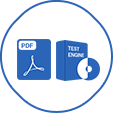Last Update 15 hours ago Total Questions : 242
The Implementing Cisco Advanced Call Control and Mobility Services (CLACCM) content is now fully updated, with all current exam questions added 15 hours ago. Deciding to include 300-815 practice exam questions in your study plan goes far beyond basic test preparation.
You'll find that our 300-815 exam questions frequently feature detailed scenarios and practical problem-solving exercises that directly mirror industry challenges. Engaging with these 300-815 sample sets allows you to effectively manage your time and pace yourself, giving you the ability to finish any Implementing Cisco Advanced Call Control and Mobility Services (CLACCM) practice test comfortably within the allotted time.
An engineer is troubleshooting local ringback on a Cisco SIP gateway The gateway is not ignoring the SIP 180 response with SDP from the service provider, and the far end device is sending the 180 with SDP to play ringback from the IP address specified m the SDP Which configuration change must be made on the gateway to resolve the issue?
An administrator configured Extension Mobility on Cisco UCM. Users report that logins are successful, but the phones do not have an Extension Mobility option after logging in. The administrator verified that Extension Mobility is enabled on the devices and that the log-out profile is valid. Which action must the administrator take to resolve the issue?
A new solution is configured to support internal, local, and international calling. Calling [+44 1111 1111] from one of the registered internal phones does not work. Local and internal calls seem to work without any problems. The configuration has patterns configured to match the failing dialed number [+44 …. ….]. The other configured patterns show [2…] for internal numbers and [555 …] for local numbers. International numbers use E.164 as recommended. What is missing to make this solution work?
Which description of RTP timestamps or sequence numbers is true?
A network engineer designs a new dial plan and wants to block a certain range of numbers (8135100 through 8135105). What is the most specific route pattern that can be configured to block only the numbers in this range?
An engineer has temporarily disabled toll fraud prevention for SIP line calls on a Cisco CME12.6x and must enforce security and toll fraud prevention for the SIP line side on Cisco Unified CME. Which configuration must be used to start this process?
An organization has decided to implement hunt groups to help with the distribution of calls between different members. The administrator must configure hunt groups on Cisco UCM. In the configuration, at which step does an administrator have the option to configure a distribution algorithm (top down, circular, longest idle time, broadcast)?

